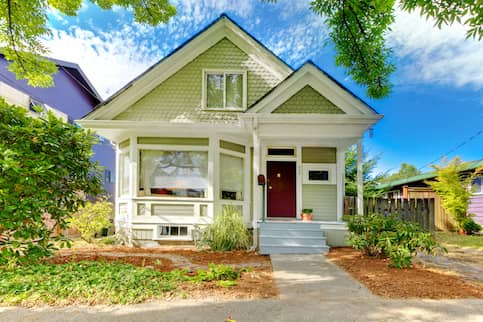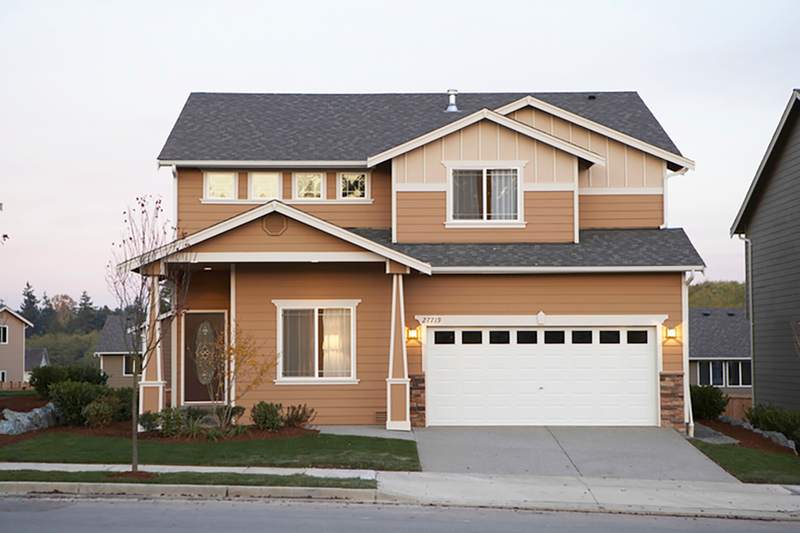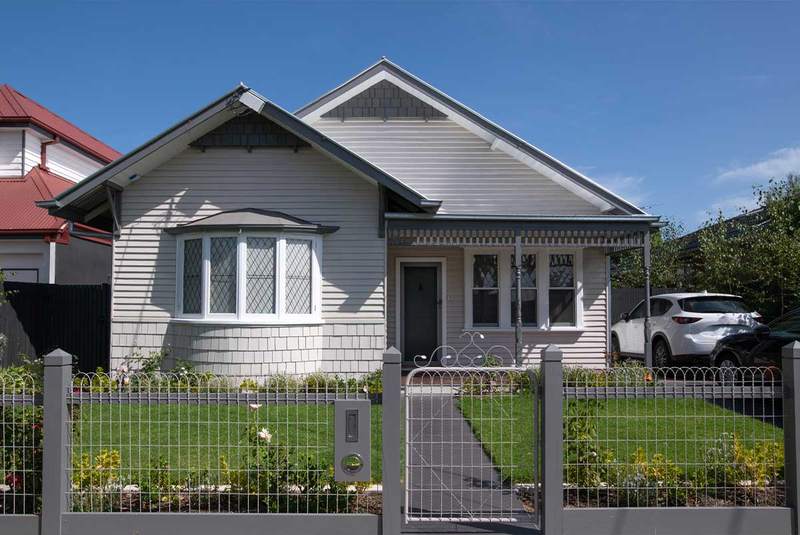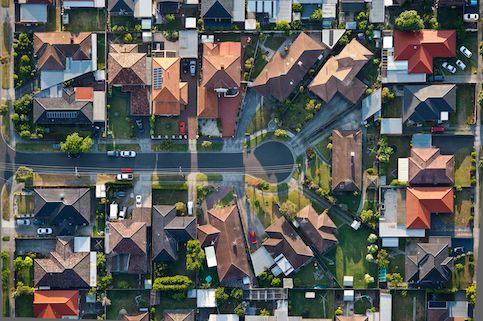Are you looking for a mortgage that requires a low down payment? Freddie Mac’s Home Possible mortgage requires a down payment of just 3% of your new home’s purchase price, making getting into a home more affordable. It can be a good fit for low-income borrowers, first-time home buyers, seniors looking to downsize and buyers with co-borrowers.
Key Takeaways:
- The Freddie Mac Home Possible mortgage program offers loans to borrowers who earn less than 80% of the area median income.
- Loans require a minimum down payment of 3%.
- Unlike FHA loans, mortgage insurance can be canceled on a Home Possible loan.
What Is A Freddie Mac Home Possible Mortgage?
The Freddie Mac Home Possible mortgage is a home loan for low-income borrowers. Eligible loan types include both conforming and super conforming loans.
For many people, saving up money for a down payment is difficult. With the median home costing more than $410,000, you’d need more than $41,000 for a 10% down payment. The Home Possible mortgage offers down payments as low as 3%.
To be eligible, you cannot earn more than 80% of the area median income where you’re buying a home.
The Home Possible mortgage also allows mortgage insurance to be canceled, which sets it apart from Federal Housing Administration loans. Mortgage insurance is a policy you pay for that protects your lender if you default on your mortgage. With a Home Possible loan, you can cancel mortgage insurance once you pay down your loan balance enough to have at least 20% equity in your home.
Freddie Mac Home Possible Vs. Home Possible Advantage
Freddie Mac also offers the Home Possible Advantage mortgage, which is similar but slightly more limited.
The Home Possible Advantage mortgage is available only to borrowers buying a one-unit primary residence. The Home Possible mortgage, by comparison, can be used to buy a home with one to four units and manufactured homes.
The Home Possible program offers fixed-rate and adjustable-rate mortgages, while Home Possible Advantage only offers fixed-rate mortgages. Your income cannot exceed 80% of the area’s median income for a Home Possible loan, while it can be 100% of the AMI, or an even higher percentage in designated high-cost areas, for a Home Possible Advantage loan.
A Home Possible Advantage loan also requires you to be a first-time home buyer. Both programs require first-time home buyers to complete a home buyer education program. You’re considered a first-time buyer if you haven’t owned a home in the past three years.
What’s Your Goal?
Buy A Home
Discover mortgage options that fit your unique financial needs.

Refinance
Refinance your mortgage to have more money for what matters.
Tap Into Equity
Use your home’s equity and unlock cash to achieve your goals.
What Is Freddie Mac?
Freddie Mac is a government-sponsored enterprise that buys mortgages that conform to its standards from private lenders. This gives lenders the funds to offer more mortgages to more borrowers.
Ready To Become A Homeowner?
Get matched with a lender that can help you find the right mortgage.
How Does A Home Possible Mortgage Work?
Before you apply for a Home Possible mortgage, it’s important to understand how it works and that you can meet the requirements. Because Freddie Mac isn’t a lender, you apply for a Home Possible loan through a private mortgage lender, just as you would with other types of home loans.
Loan Basics
Home Possible loans help low- to moderate-income home buyers with its 3% minimum down payment and by allowing the use of down payment assistance programs and other funding sources to help pay the upfront costs of buying a home.
Interest rates for Home Possible loans can be fixed or adjustable and are similar to rates offered on other loan types with low down payment requirements. The exact interest rate you pay will depend on your credit score and other financial factors.
Adjustable-rate mortgages offer a lower initial interest rate that’s fixed for a specified introductory period. After that, the rate adjusts according to market values and any increases will raise your monthly payment.
Eligible Property Types
Home Possible loans are flexible and can be used for many different property types. You can use a Home Possible loan to buy a property with one to four units, a condo, a co-op or a manufactured home.
Some restrictions and additional requirements to qualify for a Home Possible mortgage may apply if you’re buying a property other than a single-family home. For example, purchasing a multifamily property or manufactured home requires a lower loan-to-value ratio.
Down Payment
One of the ways the Home Possible program helps buyers who make less money is by keeping the down payment requirement low.
The program has a down payment requirement of 3%, meaning you can buy a home with a 97% loan-to-value ratio. Up to a 105% total LTV is allowed if you use the Freddie Mac Affordable Seconds program, which provides borrowers with a second mortgage they can use for a down payment.
The Home Possible mortgage program allows down payment funding from multiple sources. This means that in addition to your savings, you can use gift money, grants, money from secondary financing, or even sweat equity as part of the down payment and closing costs.
Minimum Credit Score
You must meet several credit-based and financial requirements to qualify for a Home Possible loan. The type of loan you’re applying for can affect those requirements.
For a fixed-rate mortgage, you’ll need a credit score of 660 or higher. If you’re buying a manufactured home, applying for an adjustable-rate loan or applying for a refinance, you’ll need a credit score of at least 680.
Maximum Debt-To-Income Ratio
To qualify for a Home Possible loan, you will also need to meet debt-to-income ratio requirements.
Your DTI ratio shows how much of your gross monthly income is required to pay your monthly debts. For most Home Possible loans, your DTI ratio cannot exceed 43%.
Mortgage Insurance
If you’re making a down payment of less than 20% of the purchase price, you’ll have to pay for mortgage insurance. How much you’ll pay depends on how much you put down. Mortgage insurance will cost more on loans with a smaller down payment and a longer term.
You can cancel mortgage insurance on a Home Possible loan for a single-family home once you have 20% equity in your home. Other loan programs, such as the FHA loan program, typically do not allow you to cancel mortgage insurance without refinancing.
Education Requirement
Home Possible mortgages also require that some home buyers go through a homeownership education program. If all the occupying borrowers are first-time home buyers, at least one must complete a program offered by an approved source.
Take The First Step To Buying A Home
Find a lender that will work with your unique financial situation.
Home Possible Income Limits
To get a Home Possible loan, you generally cannot earn more than 80% of the annual median income in your home’s area. The easiest way to determine if you meet this requirement is to enter your ZIP code into .
VLIP Credit
As of March 1, 2024, additional assistance became available to borrowers with very low incomes. If you earn 50% or less of the area median income, the very low-income purchase, or VLIP, credit offers an additional $2,500 that you can use toward your down payment and closing costs. There are no geographic or LTV restrictions on this additional assistance. This program is available through Feb. 28, 2025.
How To Apply For A Freddie Mac Home Possible Loan
Applying for a Home Possible loan is similar to applying for any other mortgage. To start, you should make sure you have enough funds available for a down payment and closing costs, and have a sense of how much house you can afford.
Next, you’ll need to find a lender that offers Home Possible loans. Check with local lenders to see if they use the program.
Finally, it’ll be time to submit your application. Mortgage applications are involved, and the lender will want you to submit financial documents, such as:
- Proof of income, such as pay stubs, to confirm income eligibility
- Personal identification, such as a driver’s license or passport
- Recent tax returns
- Bank and investment account statements
- Bills from any recurring debts, such as student or auto loans
- Gift letters verifying the source of any down payment assistance you’ve received from family, friends or employers
Freddie Mac Home Possible Pros and Cons
Freddie Mac Home Possible loans offer an opportunity for lower-income families to buy a home, but they aren’t ideal for every situation.
Pros
Here are some of the advantages of the Freddie Mac Home Possible program:
- Low down payment. You can use the loan to buy a home with as little as 3% down.
- Flexible down payment sources. Many lenders will closely examine the source of your funds, but Home Possible loans let you use grants, gifts or secondary financing to cover your down payment and closing costs.
- Cancellable mortgage insurance. You can cancel mortgage insurance on a single-family home after building 20% equity.
- Manual underwriting is available. Home Possible allows manual loan underwriting. Having a human look at your application may make it easier to qualify if you have an unusual financial situation.
- Lower fees. Fees for Home Possible loans are lower than for many other loan types.
- Credits and grants available. Some borrowers may qualify for additional credit or grants. For example, those making 50% or less of the area median income can get an extra $2,500 VLIP credit for a down payment and closing costs.
Cons
Here are some reasons the Home Possible program isn’t suitable for everyone:
- Income limits. You won’t be eligible for a Home Possible loan if you earn more than 80% of the area’s median income.
- Primary residence only. Home Possible loans can be used only to buy a primary residence. If you’re looking to buy a second home or a vacation home, you can’t use the program.
- Residency requirements. Though nonoccupying borrowers are permitted on a Home Possible loan, at least one borrower must live in the home as a primary residence.
- Stricter lending requirements. Home Possible loans are available only for certain types of properties. You can finance homes with one to four units, condos, co-ops, planned-unit developments and manufactured homes. Additionally, some loan programs, such as FHA loans, allow borrowers to have credit scores as low as 500, compared to the Home Possible minimum of 660.
- Small mortgage lending network. The network of lenders offering Home Possible loans may be smaller than if you were shopping for other types of loans. That can make it difficult to shop around and compare loan offers if you’re hoping to use the program.
Alternatives to Freddie Mac’s Home Possible Program
Freddie Mac’s Home Possible loan program is one option for people looking to buy a home, but it’s important to consider alternatives, such as these government home loans, to see if one might suit you better.
FHA Loans
If you need a mortgage with a low down payment requirement, you might want to see if you qualify for an FHA loan.
Unlike Home Possible loans, FHA loans have no income limit, making them available to more borrowers. Their down payment requirement, however, is slightly higher at 3.5%, and it jumps to 10% for those with a credit score between 500 and 579.
Another drawback of FHA loans is it’s more challenging to cancel mortgage insurance premiums. To end mortgage insurance payments, you need to either have made a 10% down payment and wait 11 years or refinance your loan.
USDA Loans
U.S. Department of Agriculture loans require no down payment but have strict requirements that make them inaccessible to many borrowers. In addition to having a maximum income limit for borrowers, USDA loans can be used only to finance the purchase of homes in eligible rural areas.
VA Loans
Veterans Affairs loans are a benefit for military service members, veterans and their eligible surviving spouses. Active members of the military qualify after serving for 90 continuous days, while veterans must meet specific requirements based on when they served. You can buy a home with no down payment or mortgage insurance if you qualify.
FAQ
Before you apply for a Home Possible loan, it’s important to make sure you understand how the program works. Here are the answers to some frequently asked questions:
The Bottom Line
If you’re looking for your first home, Freddie Mac’s Home Possible mortgage is an option for lower-income buyers. It allows borrowers to assemble a minimum down payment of 3% using various sources, including gift money, grants and second mortgages. It also allows you to cancel mortgage insurance payments to help you save money on your home loan in the long run.
More From Quicken Loans:
Miranda Crace contributed to the reporting of this article.

T.J. Porter
T.J. Porter is a Boston-based writer who focuses on credit cards, credit and bank accounts. When he's not writing about all things personal finance, he enjoys cooking, esports, soccer, hockey, and games of the video and board varieties.












